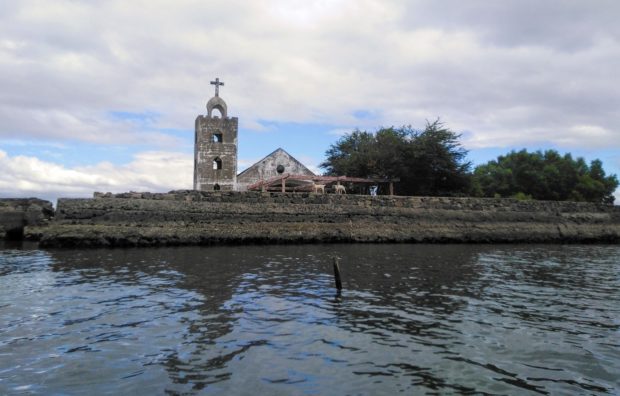
STILL STANDING: The remnants of Torres Church in the abandoned island-sitio of Kinse in Bulakan town’s Barangay Taliptip, Bulacan province, remain standing. Taliptip used to be a fishing hub until it was vacated in 2020 to give way to the P745-billion Bulacan International Airport to be constructed by San Miguel Corp. (Photo by CARMELA REYES-ESTROPE / Inquirer Central Luzon)
BULAKAN, Bulacan — Former fishermen from an islet in this town who were relocated to new homes to make way for the P745-billion Bulacan International Airport project (New Manila) have returned to fishing.
Residents of Sitio (subvillage) Kinse Island, an islet under the jurisdiction of the coastal village of Taliptip, have been provided community meat stores by food and beverage giant San Miguel Corp. (SMC), which is undertaking the airport project, when they moved to Sitio Pulo Purok 6 in Barangay Bambang here.
But because the economy remains unstable in the second year of the coronavirus pandemic, Teody Bacon, 46, and his five former neighbors had to augment their family income by catching fish, prawns and crabs. Each time they sailed out to the waters off Bambang village, each of the six men earned a minimum catch worth P1,000 to P4,000, except for the weeks in July when monsoon rains enhanced by Typhoon “Fabian” (international name: In-fa) kept them away from the sea.
Fish traps
It has been a year since they were relocated, but Bacon said he preferred the life on Kinse Island, and would return there given the chance.
The wives of Bacon and the other fishermen were also provided with freezers so they could sell SMC products to their new neighbors.
But because their husbands have gone back to fishing, they spent more of their time making woven fish traps, said Thelma Bantigue, one of the fisherfolk’s wives.
The Bacon and Bantigue families were among 300 households living in nine island communities of Taliptip who were provided with land and housing assistance by SMC.
Arvie de Asis, 30, who used to live in the coastal island of Wawang Capiz, has trained to become a heavy equipment operator who will be hired by SMC when airport construction starts. The De Asis family also settled in Pulo.
Liza Valiente from the island Sitio Bunutan has set up a small business after training to be a tailor.
Bulacan International Airport, which would rise in a 2,500-hectare property off the coast of this town, is projected to serve at least 100 million passengers yearly, or three times the size of Ninoy Aquino International Airport, the country’s main international gateway located in Metro Manila.